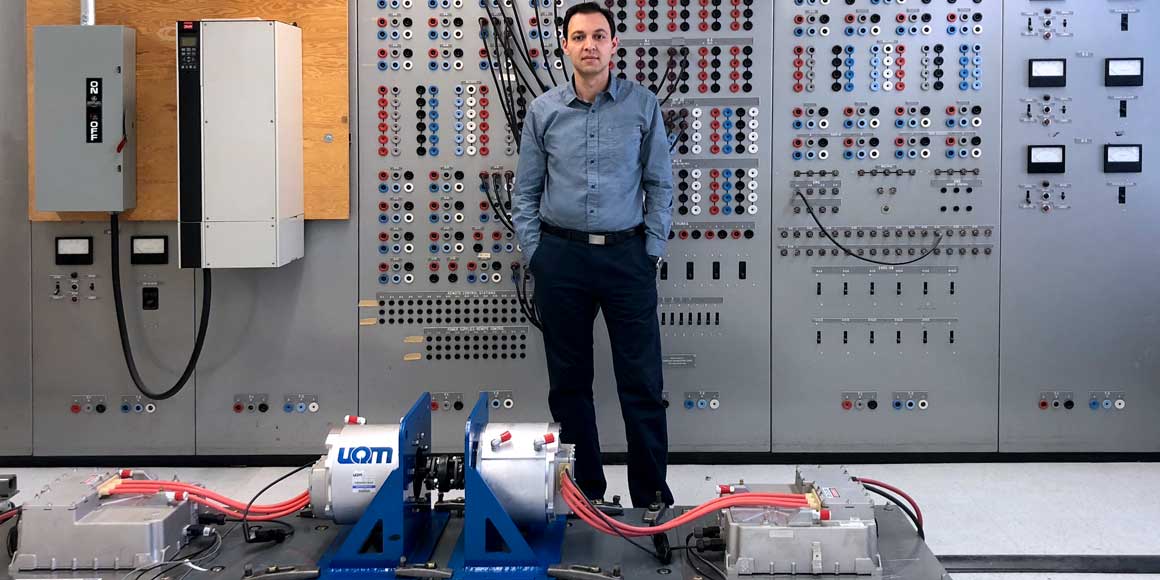The University of Nevada, Reno, has recently implemented a high-power test bench for electric vehicle research. By emulating electric vehicles, or EV for short, the test bench helps improve transportation technology and develop a more efficient motor design.
The test bench has two liquid cooled 135-kilowatt electric motors with dedicated controllers and has the capability to simulate a real size EV, which is something that assistant professor of electrical engineering and lead researcher Poria Fajri has been working on since his arrival at the College of Engineering in early 2017.
He has one doctoral student working on the project, Shoeib Heydari, who also helped build the test bench.
It was a challenging road to perfect the test bench, according to Fajri.
"Three months of our time was spent on just aligning the motors perfectly," Fajri said. "Small things can add up. If not aligned correctly, it shakes, gets really loud and can damage the motors."
This type of setup, which is capable of emulating a real size vehicle, is featured in very few colleges across the United States, Fajri said.
The simulation studies carried out by these setups enables researchers and vehicle designers to evaluate and analyze EV powertrain performance and energy consumption using realistic driving scenarios. Additionally, it allows researchers to evaluate and study EV performance and develop new control strategies in academic environments.
The test bench can simulate any vehicle that has a high power, liquid cooled 135-kilowatt motor, which is most electric vehicles on the road except for the Tesla Model S.
"EV studies rely heavily on software simulation studies, however, test bench studies with actual components provide more realistic results that are closer to the working principles of these vehicles," said Fajri. "Most EV test bench platforms use scaled components but with the test bench developed at the University, we're working with actual size hardware components, as opposed to smaller models."
Fajri said that the research carried out with real size test bench is more realistic because accuracy tends to be lost when research is downscaled.
Energy efficiency in the transportation sector is a high-impact, hot topic
"EVs are clean and efficient means of transportation and are considered the future of transportation," said Fajri. "Any investment on this technology will benefit the future of transportation and accelerate efforts towards emission reduction and clean energy for the future. If we can make EVs more efficient by even one or two percent, that is a great improvement."
Factories and research labs in California are also jumping into the trend of EV research, making parts such as battery packs, electric motors and power electronic components. Fajri says these factories and labs are a good opportunity for collaboration for the University in the future.
Currently, Fajri's main focus is on improving EV regenerative braking, or the concept of using the electric motor to recapture energy during braking and storing it as electric energy in the batteries. Regenerative braking is different than friction braking, which is the common method used in conventional vehicles.
Friction braking is based on converting the vehicle's kinetic energy to heat in order to slow down the vehicle and the thermal energy produced by the brake pads is wasted, but in regenerative braking this energy can be extracted and stored in the vehicle's battery.
The developed setup at the College of Engineering gives hands-on experience for engineering students and helps them become familiar with real, working EV components while preparing individuals and professionals for the transportation electrification industry.
{{RelatedPrograms}}
"Dr. Fajri has revised our capstone curriculum and introduced new experiments in our senior capstone lab based on his industrial experience with the Toyota Research Institute of North America," Sami Fadali, professor and chair of the electrical and biomedical engineering department, said.
In the future, Fajri also hopes to do demonstrations of his EV test bench with undergraduate students and high school students in order to motivate them to join STEM programs, familiarize them with EV technology and promote transportation electrification.












